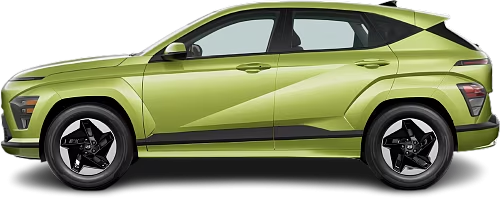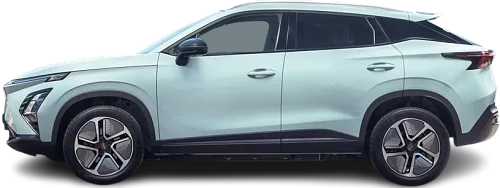Global EV Comparison: Hyundai Kona Electric Long Range vs Omoda E5 Electric
Struggling to Decide? Let AI Help!
Your AI Summary Is Ready!
General Info
Both vehicles are currently in production and can be purchased new. The Hyundai Kona Electric Long Range (2023-…) has a starting price of €47840, compared to the Omoda E5 (2024-...), which starts at €39610.
The two vehicles share the same body style: SUV.
| Property | Hyundai Kona Electric Long Range | Omoda E5 Electric |
|---|---|---|
| Years of Production | 2023-… | 2024-… |
| Current Status | Produced | Produced |
| Country of Manufacture | Czech Republic, India, South Korea | China, Malaysia |
| Body Style | SUV | SUV |
| Market Availability | EU, USA | EU |
| Price Europe (New) | €47840 | €39610 |
| Price Europe (Used) | €37390 | - Price Europe (Used) |
| GCC Score | 6.1 | 6.1 |
Range and Efficiency
The Hyundai Kona Electric Long Range (2023-…) boasts a greater real-world range, a larger battery, and superior energy efficiency compared to the Omoda E5 (2024-...).
| Property | Hyundai Kona Electric Long Range | Omoda E5 Electric |
|---|---|---|
| Range (EPA) | 420 km | - Range (EPA) |
| Range (WLTP) | 514 km | 430 km |
| Range (GCC) | 415 km | 366 km |
| Battery Capacity (Nominal) | 68.5 kWh | 64 kWh |
| Battery Capacity (Usable) | 65.4 kWh | 61 kWh |
| Efficiency per 100 km | 15.8 kWh/100 km | 16.7 kWh/100 km |
| Efficiency per kWh | 6.35 km/kWh | 6 km/kWh |
| Range and Efficiency Score | 7.6 | 6.7 |
Charging
Both vehicles utilize a standard 400-volt architecture.
The Hyundai Kona Electric Long Range (2023-…) offers faster charging speeds at DC stations, reaching up to 100 kW, while the Omoda E5 (2024-...) maxes out at 80 kW.
The Hyundai Kona Electric Long Range (2023-…) features a more powerful on-board charger, supporting a maximum AC charging power of 11 kW, whereas the Omoda E5 (2024-...) is limited to 9.9 kW.
| Property | Hyundai Kona Electric Long Range | Omoda E5 Electric |
|---|---|---|
| Max Charging Power (AC) | 11 kW | 9.9 kW |
| Max Charging Power (DC) | 100 kW | 80 kW |
| Architecture | 400 V | 400 V |
| Charge Port | CCS Type 2 | CCS Type 2 |
| Charging Score | 5.7 | 5.1 |
Performance
Both vehicles are front-wheel drive.
Both cars offer the same motor power, but the Omoda E5 (2024-...) achieves a faster 0-100 km/h time.
| Property | Hyundai Kona Electric Long Range | Omoda E5 Electric |
|---|---|---|
| Drive Type | FWD | FWD |
| Motor Type | PMSM | PMSM |
| Motor Power (kW) | 150 kW | 150 kW |
| Motor Power (hp) | 201 hp | 201 hp |
| Motor Torque | 255 Nm | 340 Nm |
| 0-100 km/h | 7.8 s | 7.2 s |
| Top Speed | 170 km/h | 172 km/h |
| Performance Score | 3.5 | 3.8 |
Dimensions
The Hyundai Kona Electric Long Range (2023-…) and Omoda E5 (2024-...) are about the same size.
Both models have similar wheelbase lengths.
| Property | Hyundai Kona Electric Long Range | Omoda E5 Electric |
|---|---|---|
| Length | 4355 mm | 4424 mm |
| Width (with Mirrors) | 2100 mm | - Width (with Mirrors) |
| Width (w/o Mirrors) | 1825 mm | 1830 mm |
| Height | 1575 mm | 1588 mm |
| Wheelbase | 2660 mm | 2630 mm |
Cargo and Towing
The Hyundai Kona Electric Long Range (2023-…) provides more cargo capacity, featuring both a larger trunk and more space with the rear seats folded.
Both models feature a convenient frunk (front trunk), providing additional storage space.
When it comes to towing, both cars offer identical towing capacity (up to 750 kg).
| Property | Hyundai Kona Electric Long Range | Omoda E5 Electric |
|---|---|---|
| Number of Seats | 5 | 5 |
| Curb Weight | 1798 kg | 1710 kg |
| Cargo Volume (Trunk) | 466 l | 300 l |
| Cargo Volume (Max) | 1300 l | 1079 l |
| Cargo Volume (Frunk) | 27 l | 19 l |
| Towing Capacity | 750 kg | 750 kg |
| Cargo and Towing Score | 6.1 | 6.3 |




